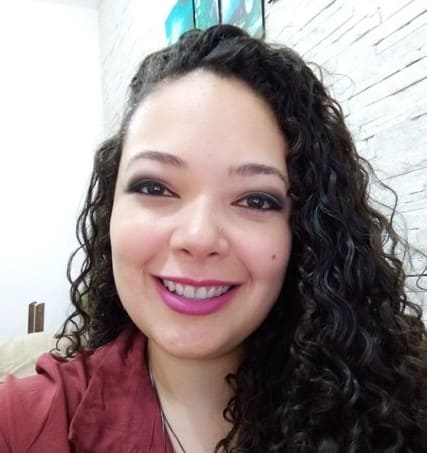ORIGINAL ARTICLE
SOUSA, Cynara Tavares de [1], CAMARGO, Patrícia Gimenez [2]
SOUSA, Cynara Tavares de. CAMARGO, Patrícia Gimenez. Challenges of bilingual teaching in Private Regular Education in Brazil. Revista Científica Multidisciplinar Núcleo do Conhecimento. Year 05, Ed. 09, Vol. 04, pp. 163-181. September 2020. ISSN: 2448-0959, Access link:
SUMMARY
The practice of bilingual teaching in Brazil has become increasingly common. Faced with a scenario that grows so vertiginously, we ask: what would be the obstacles that professionals in this area face in this contemporary school context? The purpose of this study was to survey the challenges that teachers face in the practice of private bilingual education in Brazil through the use of the Methodology Integrated Language and Content Learning or CLIL (Content and Language Integrated Learning), an educational approach studied and debated by several authors (COYLE, 2010; HOOD, 2010; MARSH, 2010). In total, 87 teachers from bilingual private schools or with bilingual programs answered the questionnaire created for this analysis that presented two phases: research on the knowledge of the language itself and the experience in the profession in the current context. Five key challenges have been identified. They were the students’ indiscipline; adapting the content or class to students with different levels of language knowledge; students with learning difficulties; problems with school management and the number of students in the classroom. With this result we can conclude that in the context of bilingual teaching in the Brazilian scenario deprived of regular education, the challenges differ from those already studied worldwide.
Keywords: Bilingual teaching, CLIL, bilingual teaching.
1. INTRODUCTION
The teaching of the English language in Brazil did not begin recently, in fact it began in 1809 when D. João VI fled Portugal and came to Brazil (LIMA, 2017). With the advance of globalization, the mastery of a second language has become increasingly necessary for social, cultural, technological and commercial purposes, language, lingua franca for these purposes. The English language. As this demand for learning the English language grows, so does the need to master this language earlier and earlier.
This global evolution also brings the need for teachers increasingly prepared to act in the context of bilingual education and, with this, also arise the challenges of the practice that faces today a scenario never before seen: that of bilingual regular education, a scenario that takes place, primarily, through the CLIL approach (COYLE, 2010; HOOD, 2010; MARSH, 2010), which is an educational approach focused on both the content and the language by which this content is taught.
Considering that any educational approach presents, after a certain time of implementation, challenges and points of reflection, in the case of CLIL would not be different, it begins now, after more than twenty years to bring points of consideration both related to practice and teaching and starting from this movement there is reflection on what are the main challenges of bilingual teaching in private regular education in the Brazilian context.
The aim of this article is to know and better understand the challenges that teachers face in this bilingual process in Brazil, challenges that are still of ignorance in the area of education. Through the discoveries made it will then be possible for directors and coordinators to better direct the process of training these professionals who often do not undergo training in the area and end up without the necessary support to perform quality school work.
The interest in the discovery of these challenges occurred through the very need of the author who works with the training of bilingual teaching teachers, from the intention of better developing the professionals he attends, so the need arose to understand what real situations happen within the classroom that may affect the work of the bilingual teacher.
A field research with teachers working in bilingual teaching was carried out with the objective of generating the raised of these challenges. Voluntarily, professionals answered a questionnaire developed by the author and triggered in groups related to bilingual teaching in social networks, this questionnaire was developed cautiously in order to offer the maximum of causes that can affect the work of the teacher; there are also specific questions to map the region, proficiency and schooling of these volunteers. Furthermore, a filtering system was added, which makes it impossible for those who are not within the field of interest of the study to participate. After the collection phase, the results were studied and the five main challenges listed by percentage. There is, then, a final reflection that discusses the results of this study.
2. A BRIEF DISCUSSION ON THE BILINGUAL MARKET
2.1 BILINGUALISM
The concept of bilingualism involves many spheres, but let’s start with formal terminology. The Cambridge dictionary, for example, defines bilingualism as the ability to use two languages equally well. The Oxford dictionary determines that it is the fluency or use of two languages, a definition that resembles that of the Michaelis dictionary of Portuguese language.
We will stick in this study to bilingualism in its understanding of the educational aspect. In his book Foundations of Bilingual Education and Bilingualism, Colin Baker explains bilingualism by analyzing it in different dimensions and even mentions that it is impossible to define who, in fact, is bilingual or not, since it takes several factors into consideration, such as: skill, age, culture, use, balance of the two languages, development, context and elective bilingualism.
Cambridge International Examinations (Cambridge) uses the term “bilingual” or “Bilingualism” to refer to individuals or groups who routinely use two or more languages for communication in varied contexts. However, there are many definitions and understandings of the term “bilingual”, for example, a degree of competence in two languages.
2.2 BILINGUAL EDUCATION
Cambridge uses “bilingual education” to refer to the use of two or more languages as means of instruction for “content” subjects such as science or history. For Cambridge in bilingual education students learn subjects not related to language, for example geography and history through their first language (L1) and other non-linguistic subjects such as science and mathematics through a second / additional language (L2). Alternatively, students can study the same subject through two languages.
In any case, bilingualism differs from bilingual education. Bilingual education concerns that “in which two languages are used as a means of instruction” (HORNBERGER, 1991, p. 217) or, according to Genesee (1987, p. 1), “bilingual education is the instruction that occurs in school in at least two languages”.
One of the most common senses is to believe that bilingual education is a recent phenomenon, which arose with globalization, but we can even think, roughly, that Brazil went through this movement, even if informally, long before, since school for Indians in Brazil begins to be structured from 1549, when it comes to the national territory the first Jesuit mission sent from Portugal by D. João III composed of missionaries of the Society of Jesus with Father Manuel Nóbrega as chief. To make themselves understood by the Jesuits, the other Indians of the village and the settlers, the Christian Indians were forced to learn the Portuguese language.
However, the teaching of the English language in Brazil was made official on June 22, 1809 together with French, leaving Latin and Greek to be the languages taught. This insertion occurred after the decree of D. João IV who supported his decision in the argument that they were the ones that had the most distinguished place among living languages and that would have more importance to the state and would rise to the degree of prosperity of public education.
2.3 CLIL
According to Coyle; Hood and Marsh (2010) Integrated Language and Content Learning (CLIL) is an educational approach focused on both content and the language by which this content is taught, i.e. during the teaching and learning process there is focus not only on one, but on both.
According to Puffer (2011) although L in CLIL means language, the approach is mostly implemented in English. Puffer (idem) also suggests that CLIL can be interpreted as “a measure of foreign language enrichment packaged in content teaching”.
The growing interest in the CLIL approach can be understood through the analysis of teaching practices that are more appropriate for the present day. Globalization together with economic and social issues have had a significant impact on the reflection of those who learn a language, at what point of its development it is developed and in what way this learning.
2.3.1 THE STUDY
Every educational approach presents, after a certain time of implementation, challenges and points of reflection, in the case of CLIL would not be different, officially named with this acronym in 1994 (POKRIVČÁKOVÁ, 2015), the approach now begins, just over twenty years later, to bring points of consideration both related to practice and teaching.
According to Banegas, in his study CLIL teacher development: Challenges and experiences (2012) the challenges of CLIL begin with school administrators when choosing the approach, but do not understand their own needs in the face of bilingual programs and end up passing these uncertainties and lack of knowledge to the teachers who are responsible for the classes. Questions more related to the teacher, as a professional, were also raised through structured questionnaires in a study conducted by Pena Díaz and Porto Requejo (2008), this study was conducted after monitoring the implementation of bilingual programs in 150 basic education schools in Madrid and proved that the lack of knowledge of the English language directly affected the success of the implementation of the CLIL approach.
In addition to the lack of knowledge of the language, teachers also reported that although they did not have formal training on bilingual educational methodologies, they do not consider the need for theoretical training, but rather practical knowledge.
In the webinar “CLIL won’t kill” taught by Gary Anderson and broadcast by Cambridge English Teacher in 2014, which lists the five main challenges of CLIL around the world, presents how the difficulties: the level of English of the teacher, which is sometimes lower than that of students, the absence of teaching techniques, the form of evaluation and the doubt about how to evaluate the student , if via content or language and frequency. Another issue raised is that of the didactic material, there are many materials developed for the teaching of subjects in English, but do not always correspond with the national curriculum base of the country in question, and this lack of correspondence is the last challenge raised.
Still in the focus of the professional, a series of interviews that investigated which factors helped the teacher to succeed in CLIL programs, revealed that the main factors included: training opportunities, support of immersion centers and teaching materials, in this order (MEHISTO’S, 2008). The same study complements that addressing these factors is crucial to guarantee the quality of the approach (COYLE, 2007), but when interviewed, the coordinators and school managers admitted that these factors were never, in fact, directed.
2.3.2 RESEARCH
Data collection was done through a specially structured questionnaire answered online by 106 bilingual education volunteers who currently teach in the regular education market in the country.
The questionnaire was conceived based on the analysis of articles on bilingualism and challenges of teaching practice and the professional experience of the author of this research and was structured in two parts: the first part “About the teacher” aims to screen volunteers in order to really filter who works with private and bilingual education currently and the second part “On teaching practice” aims to focus on aspects of the region , training and routine of this teacher, as well as the challenges he faces in his practice.
In order to better filter the information, the choice was limited to five challenges that the volunteers pointed out using their own experience. Data analysis was done through appreciation and with the help of the Google Forms tool that filters data and presents it individually or generally via quantity and percentage.
3. Results
We will present and discuss the results of the survey conducted with 106 volunteers. The presentation will follow the order of the questions and the chart will display via color, in quantity and percentage the answers collected.
Figure 1: Do you teach English or via English today?
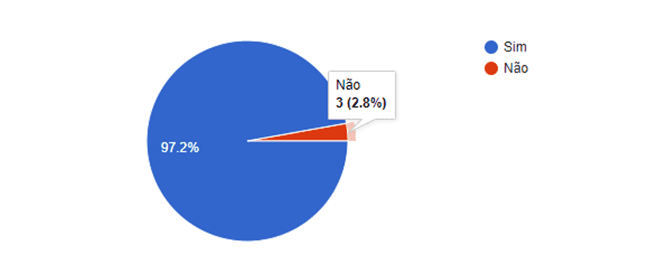
Considering that the study aims to analyze the challenges of bilingualism in the current context, the first question aims to filter the volunteers who teach via English on this date (2018) in the country. If the professional does not, he is automatically directed to the thank you page for the collaboration and does not have access to the rest of the questionnaire. In this case, we can observe that 106 professionals were willing to answer the questions and collaborate with the research, with 103 being the actual number of people who teach via English.
Graph 2: Where do you currently teach?
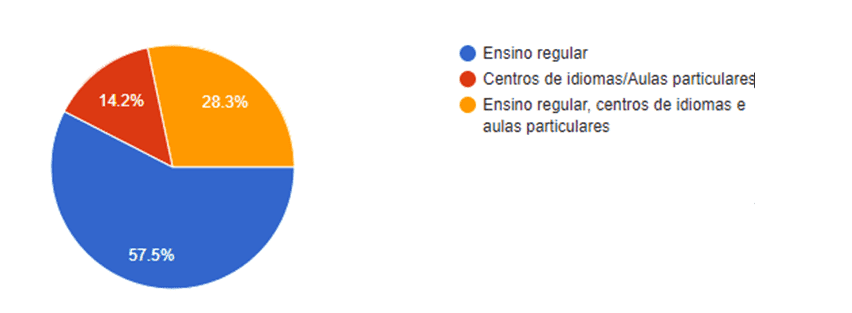
The second question aims to observe in which segment of teaching these professionals are currently and to filter those who do not teach in the area of study that is basic regular education. If the professional does not, he is automatically directed to the thank you page for the collaboration and does not have access to the rest of the questionnaire.
By observing the graph, we can notice that 85.8% of the volunteers are in the area desired for this study.
Graph 3: About the teacher – In which region of the country do you teach?
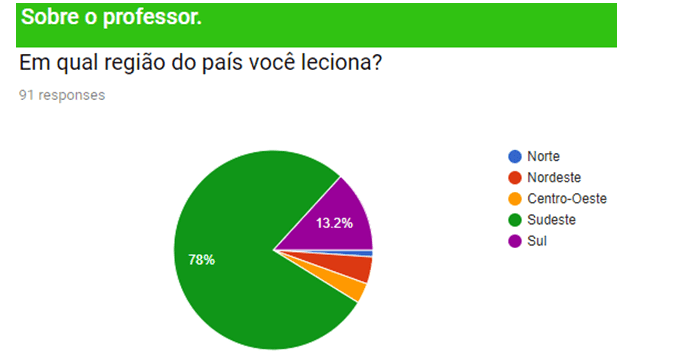
By completing the filtering of volunteers who teach in primary education, we started the section focused on the professional. We can observe in the graph above that of the 103 initial volunteers, 91 teach within the regular Brazilian education at the moment being, mostly, professionals working in the southeast region of the country.
Graph 4: Do you work in the public or private elementary school network?

After distinguishing between those who teach in Brazilian basic education, we move on to the screening moment, which aims to focus on bilingual primary education professionals. At this moment we can observe that of the initial 106 volunteers, 91 reached this phase and most of them are inserted in regular private bilingual education.
Figure 5: What is your higher education?
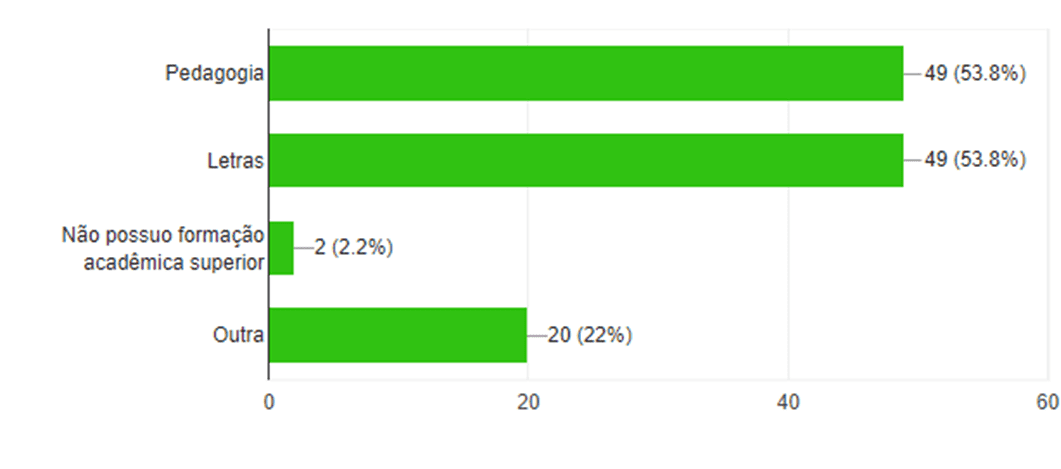
18)
On higher education, we can observe that most of the interviewees are graduated in the areas of Pedagogy and Letters, followed by professionals graduated in other areas.
Graph 6: Which teaching tracks do you teach?
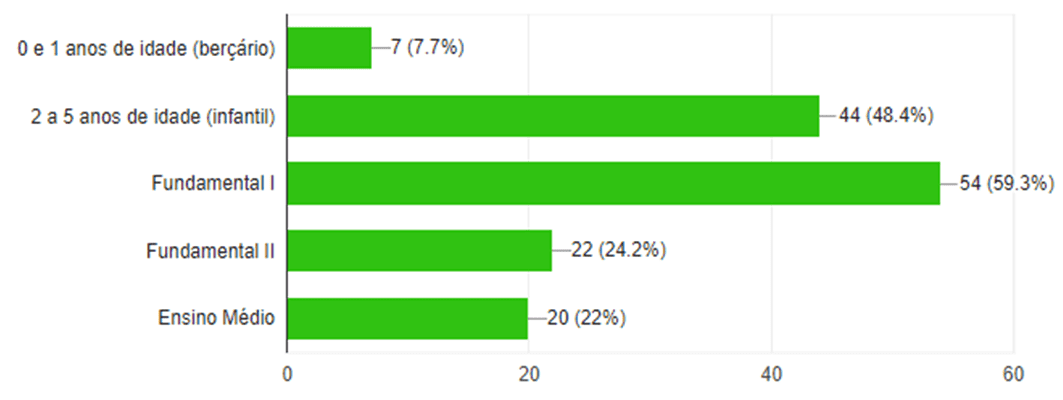
)
It is also possible to observe that most professionals teach in early childhood and elementary education 1.
Graph 7: How did you learn the English language?
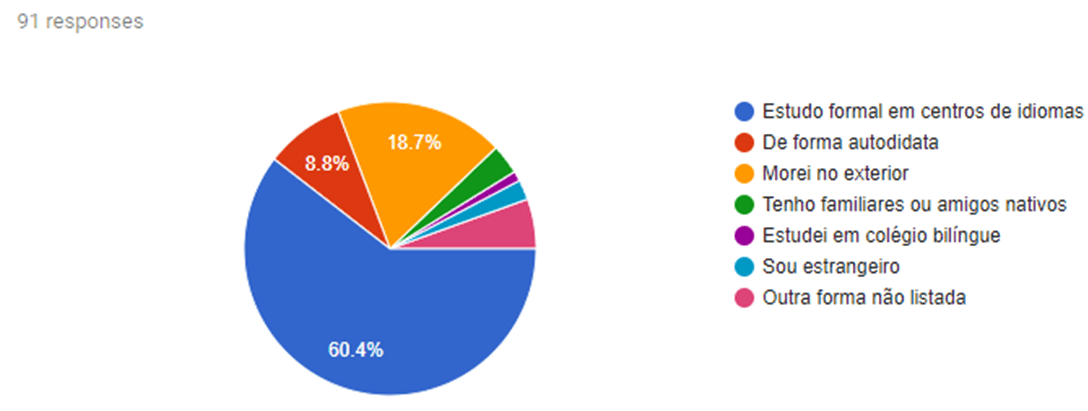
18)
When asked about the learning of the English language itself, we can see that more than half of the interviewees formally learned the language in language teaching centers.
Figure 8: How long have you been teaching English or via English?
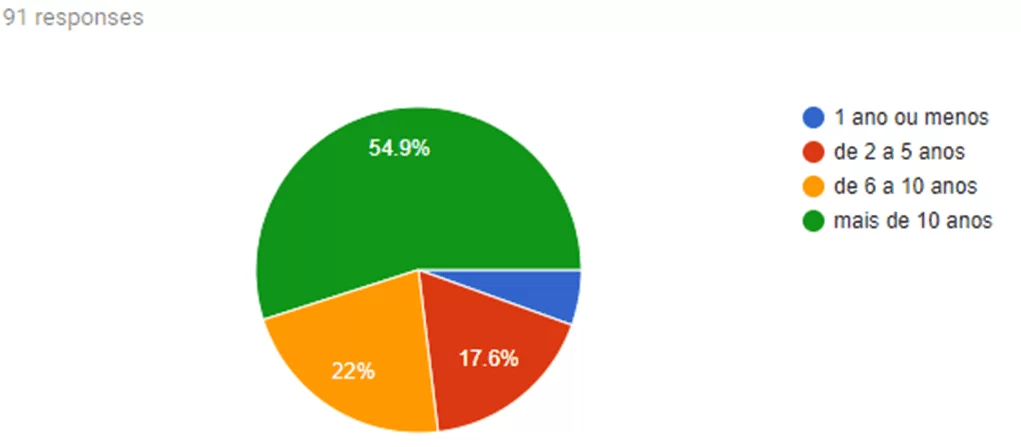
Regarding the experience time of the interviewees, we can observe that 54.9% have been teaching language or via English for more than ten years.
Figure 9: What is your level of English proficiency?
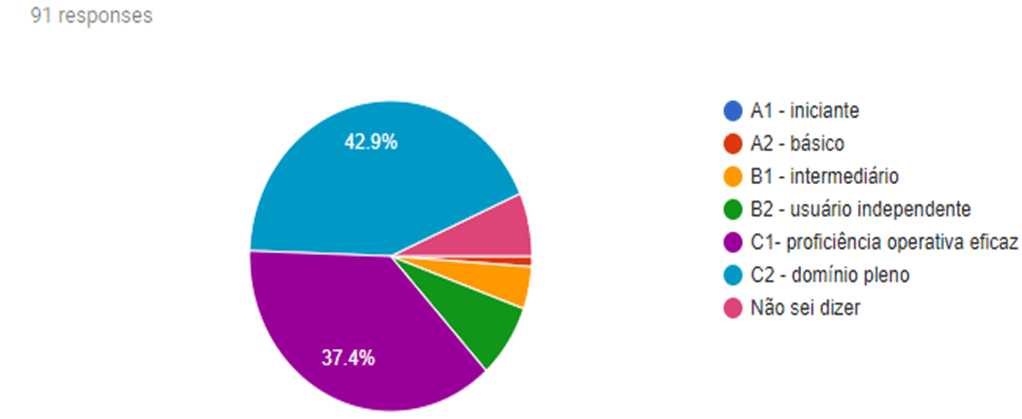
(2018)
When asked about English proficiency, it can be observed that 80.3% have a high level of proficiency.
Figure 10: Do you have any English language teaching certificates?
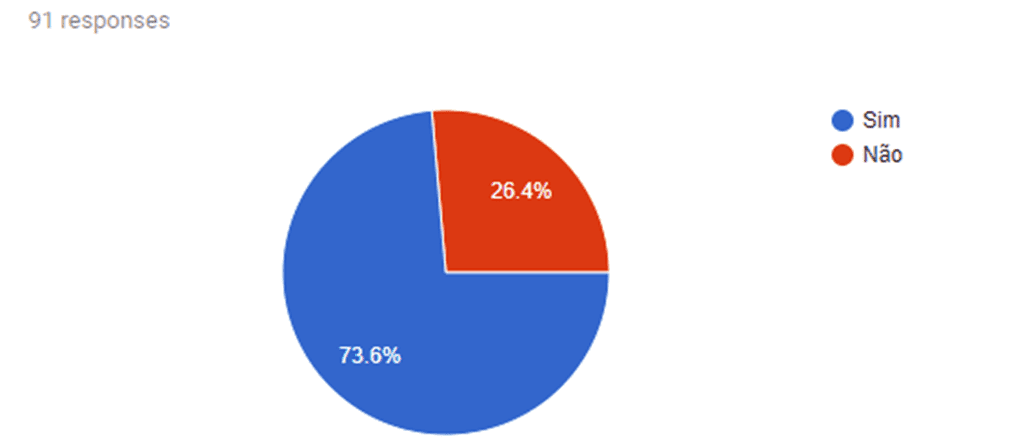
About certifications in the area of teaching in the language, a quarter of respondents say they do not have.
Figure 11: How many classes do you teach for today?
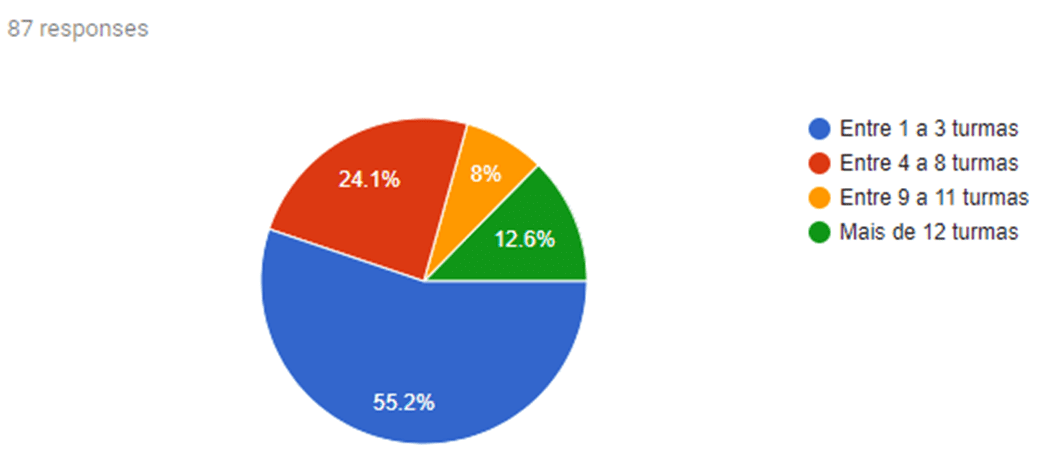
)
It is time to interview the volunteers about their own teaching practice, at this moment we reached the real and organic number of professionals inserted in the area desired for this study, which is brazilian private basic regular education. Of the initial 106 volunteers, 87 are in the field of observation of this study and more than half of these professionals teach between one and three classes in their daily practice.
Graph 12: What is the average amount of students per class you teach in regular primary school?
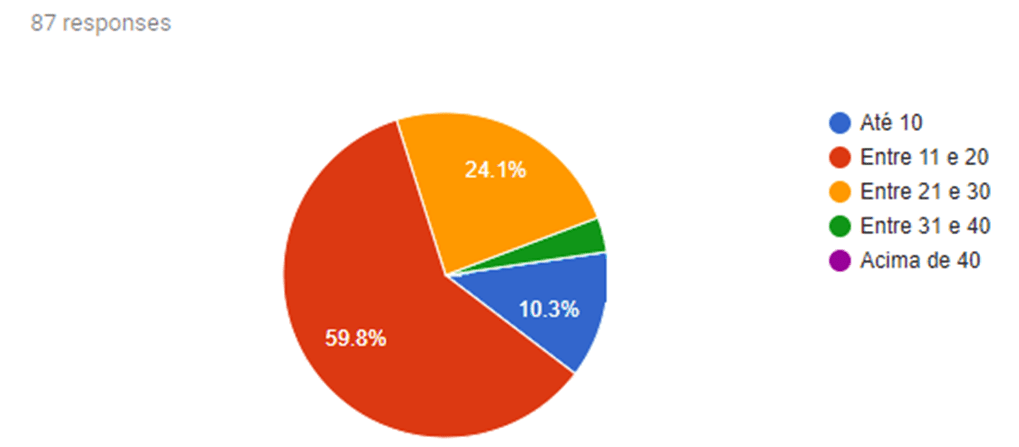
I
t is possible to observe that the average of students per class of these professionals is between 11 and 20, it is also possible to notice that none of the interviewees has classes with more than 40 students.
Figure 13: Does the school you work at offer continuing training to teachers?
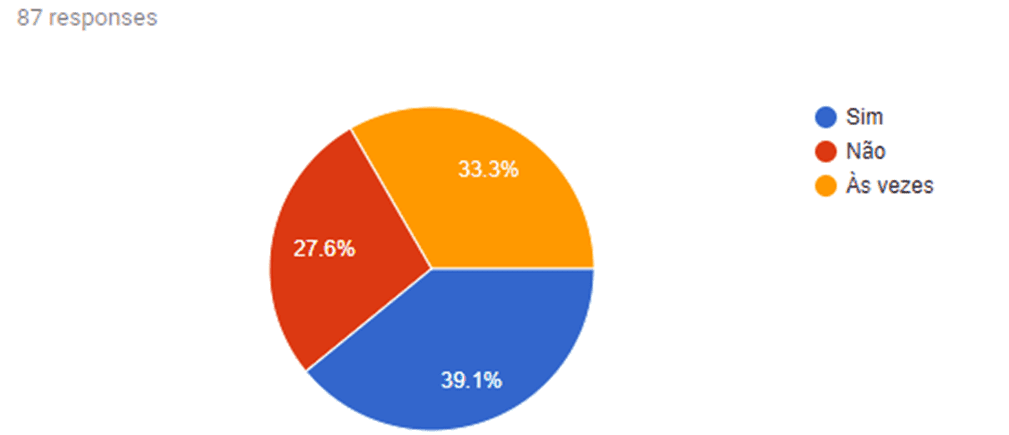
8)
Regarding teacher training, it is possible to affirm that 24 of the 87 professionals interviewed work in places that do not offer any continuous training to teachers.
Figure 14: How often do you receive feedback on your teaching practice?
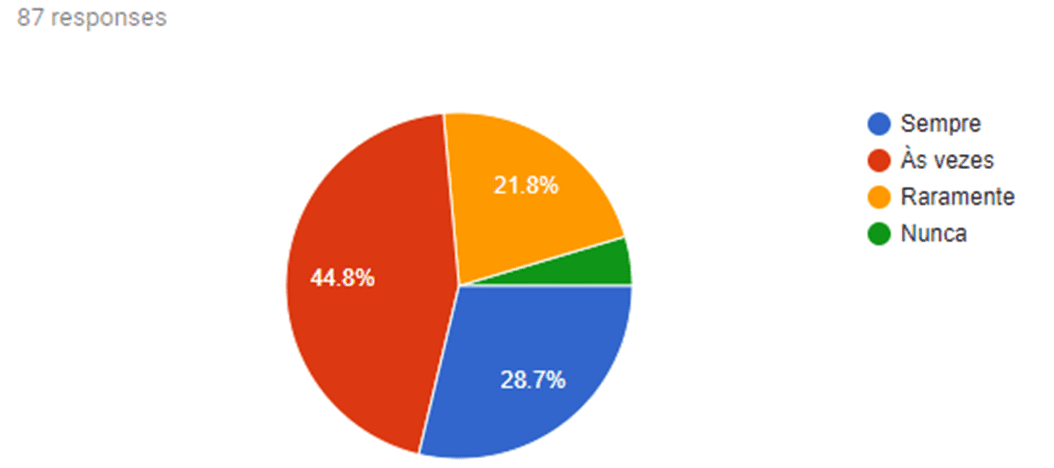
When asked about the frequency with which they receive feedback about their own teaching practice, 44.8% of the interviewees occasionally admit to receiving them.
Graph 15: Mark the 5 options that best reflect your difficulties in the classroom:
Source:
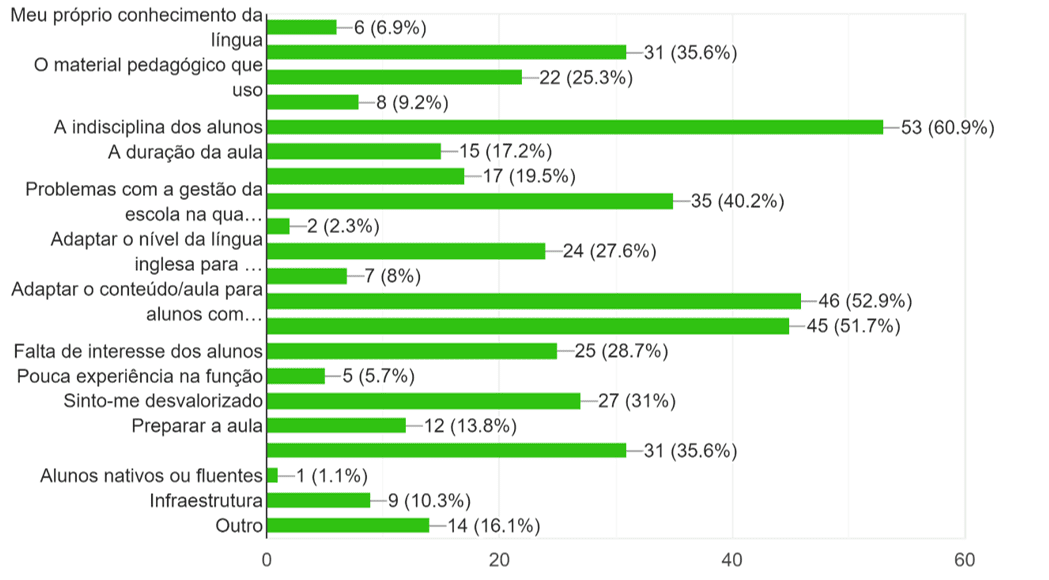
The l
ast topic of the questionnaire is about the central theme of this research and questions the volunteers about the five main challenges they face from the practice of teaching in regular and private bilingual teaching in Brazil. Twenty-one challenge options were presented and the volunteers approached them according to their own experience, the order of the options varied from volunteer to volunteer. The options and their respective results were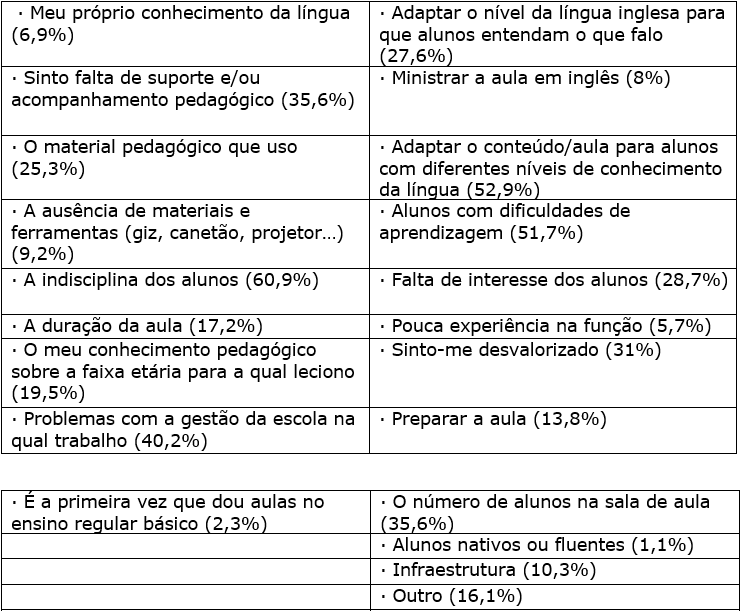 :
:
Firstly, voted by 53 of the 87 teachers, is the “Student Indiscipline” followed by the option “Adapt content/class for students with different levels of knowledge of the language” with 46 votes. In third place is the option “Students with learning difficulties” with 45 votes and fourthly is “Problems with the management of the school in which I work”. The last place in the ranking was tied between two challenges: “The number of students in the classroom” and “I miss support and/or pedagogical accompaniment” both totaling 31 votes each.
There was also room for extra comments at the end of the questionnaire and some of the other challenges mentioned included questions related to the use of Portuguese by the classroom assistant, the attitude and expectation of parents regarding the function of the school, requirement of treatment with exceptions to school rules and regarding the school that yields to the requirements of parents.
It was also criticized the variation of bilingual teacher salary and the curriculum in English of subjects of which students have little repertoire, since they are predominant Lysians and are immersed in the Portuguese language, and having the teacher the responsibility of making this curriculum happen in its entirety.
4. Discussion
According to the data presented, we evaluated that, in the Brazilian context, the number one challenge listed by the professionals in the area in the questionnaire elaborated especially for this study is related to the indiscipline of students in the classroom.
Both in the study by Pena Díaz and Porto Requejo (2008) and in the webinar “CLIL won‘t kill” taught by Gary Anderson (2014), the level of proficiency of the English language proved to be a challenge, but in the questionnaire of this study this question was not listed as some of the main challenges being six of the 87 organic participants of this research who mentioned this point.
There were none of the topics that were not listed by any of the participants, all were chosen at least once, such as the challenge of having some native or fluent student.
5. FINAL CONSIDERATIONS
The present study aimed to understand and list the main challenges of bilingual teaching in the Brazilian private scenario. This research took place in three main phases that were: a brief analysis on bilingualism, the collection of responses from volunteer teachers who work in the area through a questionnaire and the analysis of these data.
According to the results found, we can conclude that, in the context of bilingual teaching in the Brazilian private scenario of regular education, the challenges differ from those already studied worldwide. In Brazil, the bilingual teacher sees indiscipline as a greater challenge, followed by the difficulty in adapting the content or class for students with different levels of knowledge of the language, students with learning difficulties, problems with school management and the number of students in the classroom, in addition to the feeling of lack of support or pedagogical accompaniment.
We should consider, however, that the research collected the experience of 87 teachers who are mostly based in the southeast region of the country, it is necessary, then, research involving more professionals from different regions so that these data are analyzed and have a more real measurement that there is or is not a prevailing pattern in the results.
REFERENCES
ALIC, M. Bilingualism/Bilingual education. Disponível em: < http://www.healthofchildren.com/B/Bilingualism-Bilingual-Education.html>. Acesso em: 29/04/2018.
ANDERSON, G. The 5 Challenges of CLIL – (05m14s) – Cambridge English Teacher. Disponível em: < https://www.youtube.com/watch?v=mm8216t4Uaw>. Acesso em: 12/05/2018.
BANEGAS, D. L. (2012). CLIL teacher development: Challenges and experiences. Latin American Journal of Content & Language Integrated Learning, 2012. Disponível em: < https://www.unifg.it/sites/default/files/allegatiparagrafo/20-01-2014/banegas_clil_teacher_development.pdf). Acesso em: 18/04/2018.
CAMBRIDGE INTERNATIONAL EXAMINATIONS. Bilingual learners and bilingual education. Cambridge, 2015. Disponível em: <http://www.cambridgeinternational.org/images/271190-bilingual-learners-and-bilingual-education.pdf>. Acesso em: 08/05/2018.
COYLE D., HOOD P., MARSH D. (2010). Content and Language Integrated Learning. Cambridge: Cambridge University Press.
DALTON-PUFFER, C. (2011). Content-and-language integrated learning: From practice to principle? Annual Review of Applied Linguistics, 31(1), 182-204.
EU, ESTUDANTE. Estudo aponta quais são as principais reclamações dos professores. Disponível em: <http://www.correiobraziliense.com.br/app/noticia/eu-estudante/professor/2015/03/30/professor_interna,477560/estudo-aponta-quais-sao-as-principais-reclamacoes-entre-professores.shtml>. Acesso em: 29/04/2018.
LAVROV, A. What made English the lingua franca? Disponível em: <https://www.quora.com/What-made-English-the-lingua-franca>. Acesso em: 29/04/2018.
LIMA, D. Como começou o ensino de inglês no Brasil? Disponível em: < https://www.inglesnapontadalingua.com.br/2017/03/como-comecou-o-ensino-de-ingles-no-brasil.html>. Acesso em: 29/04/2018.
MARSH, David on CLIL. 2010. (09m08s). Disponível em: <https://www.youtube.com/watch?v=-Czdg8-6mJA>. Acesso em: 12/05/2018
MELLO, H. A. B., Educação bilíngue: uma breve discussão, 2010.
MINISTÉRIO DA EDUCAÇÃO. Educação Escolar Indígena: diversidade sociocultural indígena ressignifi cando a escola. Brasília, abril de 2007. Disponível em: http://portal.mec.gov.br/secad/arquivos/pdf/educacaoindigena.pdf. Acesso em: 20/04/2018.
PENA DÍAZ, C. & PORTO REQUEJO, M. (2008). Teacher beliefs in a CLIL education project. Porta Linguarum, 10, 151-161.
REVISTA EDUCAÇÃO. Dois idiomas, uma criança. Disponível em: <http://www.revistaeducacao.com.br/dois-idiomas-uma-crianca/>. Acesso em: 04/05/2018.
SANTOS, E. E. O Ensino Da Língua Inglesa No Brasil. BABEL: Revista Eletrônica de Línguas e Literaturas Estrangeiras n.01, dezembro de 2011.
SIMAS, A. Professores e os desafios dentro da sala de aula. Disponível em: <http://www.gazetadopovo.com.br/educacao/professores-e-os-desafios-dentro-da-sala-de-aula-bsmeehc611tmnmdyxmr5jrjny>. Acesso em: 30/04/2018.
SOUSA, C. T. Os principais desafios da docência bilíngue no ensino regular privado no Brasil, 2018. Disponível em: < https://docs.google.com/forms/d/1MxV8K3JzRspghjPqbrngZQYwOnZp0KXV3Q5PdjXS3FY/edit#responses>. Acesso em: 31/03/2019.
[1] Postgraduate in Psychopedagogy (2015), Degree in Letters – English (2018), Graduation in Pedagogy (2018) and Bachelor’s degree in Translation and Interpretation (2009).
[2] Guidance counselor. PhD in Translation Studies. Master’s degree in Linguistics. Specialization in Clinical and Institutional Psychopedagogy. Specialization in School Management. Specialization in English Grammar. Graduation in Letters / Interpret translator.
Sent: December, 2019.
Approved: September, 2020.
